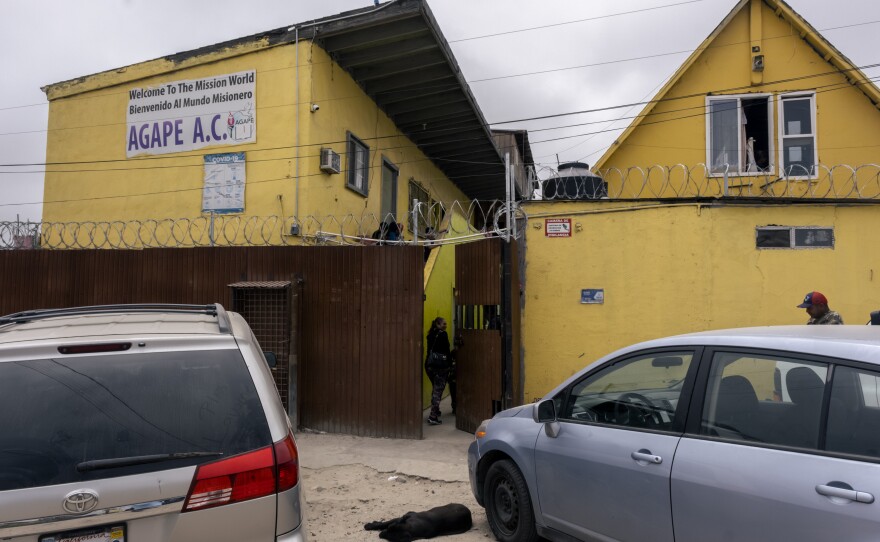There are roughly 16,000 vulnerable migrants in Tijuana waiting to enter the United States. But 11 days before the gates will be opened allowing them to seek asylum, U.S. officials haven’t told their Mexican counterparts exactly how they plan to process all of those people at the border.
“The migrants are going to want to leave the shelters and get in line at the port of entry,” said Enrique Lucero, the head of Tijuana’s migrant affairs department. “They are going to want to wait for their turn. They will sleep there, eat there until their turn is up.”
Since the start of COVID-19, the U.S. has used the controversial public health order Title 42 to turn away asylum seekers at the border nearly 3 million times, according to data from Customs and Border Protection. That includes vulnerable asylum seekers, who never got a chance to plead their case to an immigration judge.
Title 42 is set to be lifted May 11. But without clear guidance from the United States, Tijuana officials anticipate chaos.
Last week, the Department of Homeland Security announced a broad series of policies set to replace Title 42. They include cracking down on people who enter the country illegally and creating new legal pathways into the country.
Another part of the plan is for Latin American countries to stop migrants from reaching the border in the first place. So U.S. officials will open processing centers in Colombia and Guatemala where migrants can go to see if they are eligible for asylum in the U.S. without having to go to the border.
Despite these announcements, the Biden administration hasn’t communicated on-the-ground logistics of what will happen at the border. Lucero doesn’t know exactly how many migrants will be allowed to enter San Diego every day, and when or where they should line up.
Once Title 42 is lifted, migrants will go through an expedited removal process including a credible fear interview, where they explain why they are seeking asylum in the U.S. Those who pass are allowed to pursue asylum claims and those who fail are deported.
“The Biden administration has said it’s going to be surging asylum officers and other resources down to the border to carry out these interviews,” said Aaron Reichlin-Melnick, policy director at the American Immigration Council, a pro-immigration think tank.
The closest thing Tijuana officials have to an official plan is from December 2022. That’s when the Biden administration tried to lift Title 42 but was blocked by a federal judge. Back then, U.S. officials told Lucero that they would allow roughly 200 migrants to enter the United States each day.

Tijuana has a major backlog of roughly 14,000 to 16,000 migrants waiting for a chance to cross into the United States. And hundreds more arrive each day. Shelter operators anticipate an influx of new migrants at the border once the Title 42 restrictions are lifted.
Allowing just 200 to cross isn’t going to alleviate Tijuana’s migrant situation, Lucero said.
“If they only process 200, chaos will be inevitable,” he said.
“The migrants are going to want to leave the shelters and get in line at the port of entry. They are going to want to wait for their turn. They will sleep there, eat there until their turn is up.”Enrique Lucero, the head of Tijuana’s migrant affairs department
Roughly 650 men, women and children are currently living in Tijuana’s Agape migrant shelter. Pastor Albert Rivera is currently building another dormitory to expand the capacity to 1,200.
“We do know that a lot more immigrants are going to come now that Title 42 is going to be taken away,” he said.
The shelter is also preparing for a post-Title 42 era by helping migrants prepare to fight for their asylum cases in immigration court.
The majority of people who apply for asylum are denied, according to data from the Transactional Records Access Clearinghouse at Syracuse University. The asylum denial rate in fiscal year 2022 was 52%, according to federal data.
“Just because you get to enter the United States, doesn’t mean you’ll be able to stay,” Rivera said.
At the shelter, volunteers help migrants prepare photos, documents and other forms of proof that could help back up their case.
“We focus on evidence and documentation,” Rivera said. “We tell them, 'do you want to do things legally, do you want to win your case? Focus on the evidence and be a little patient.'”
The high number of migrants at the border should decrease as soon as the backlog is addressed, said Reichlin-Melnick. But that depends on how the Biden administration handles the anticipated surge.
-
Title 42, the controversial public health order that allows officials to turn away asylum seekers at the border, lifts on May 11.
-
As Bed Bath & Beyond closes more stores nationwide, enterprising home cooks are heading to restaurant supply stores for their kitchen essentials.















